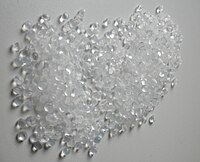Polythene
 |
|
 |
|
 |
|
| Names | |
|---|---|
|
IUPAC name
Polyethene or poly(methylene)
|
|
| Other names
Polyethene
|
|
| Identifiers | |
|
9002-88-4 |
|
| Abbreviations | PE |
| ECHA InfoCard | 100.121.698 |
| KEGG |
C19503 |
| MeSH | Polyethylene |
| Properties | |
| (C2H4)n | |
| Density | 0.91–0.96 g/cm3 |
| Melting point | 115–135 °C (239–275 °F; 388–408 K) (239–275 °F) |
| −9.67×10−6 (HDPE, SI, 22°C) | |
|
Except where otherwise noted, data are given for materials in their standard state (at 25 °C [77 °F], 100 kPa).
|
|
| Infobox references | |
Polyethylene (abbreviated PE) or polyethene (IUPAC name polyethene or poly(methylene)) is the most common plastic. The annual global production is around 80 million tonnes. Its primary use is in packaging (plastic bags, plastic films, geomembranes, containers including bottles, etc.). Many kinds of polyethylene are known, with most having the chemical formula (C2H4)n. PE is usually a mixture of similar polymers of ethylene with various values of n.
Polyethylene was first synthesized by the German chemist Hans von Pechmann, who prepared it by accident in 1898 while investigating diazomethane. When his colleagues Eugen Bamberger and Friedrich Tschirner characterized the white, waxy substance that he had created, they recognized that it contained long –CH2– chains and termed it polymethylene.
The first industrially practical polyethylene synthesis (diazomethane is a notoriously unstable substance that is generally avoided in industrial application) was discovered in 1933 by Eric Fawcett and Reginald Gibson, again by accident, at the Imperial Chemical Industries (ICI) works in Northwich, England. Upon applying extremely high pressure (several hundred atmospheres) to a mixture of ethylene and benzaldehyde they again produced a white, waxy material. Because the reaction had been initiated by trace oxygen contamination in their apparatus, the experiment was, at first, difficult to reproduce. It was not until 1935 that another ICI chemist, Michael Perrin, developed this accident into a reproducible high-pressure synthesis for polyethylene that became the basis for industrial LDPE production beginning in 1939. Because polyethylene was found to have very low-loss properties at very high frequency radio waves, commercial distribution in Britain was suspended on the outbreak of World War II, secrecy imposed, and the new process was used to produce insulation for UHF and SHF coaxial cables of radar sets. During World War II, further research was done on the ICI process and in 1944 Bakelite Corporation at Sabine, Texas, and Du Pont at Charleston, West Virginia, began large-scale commercial production under license from ICI.
...
Wikipedia
